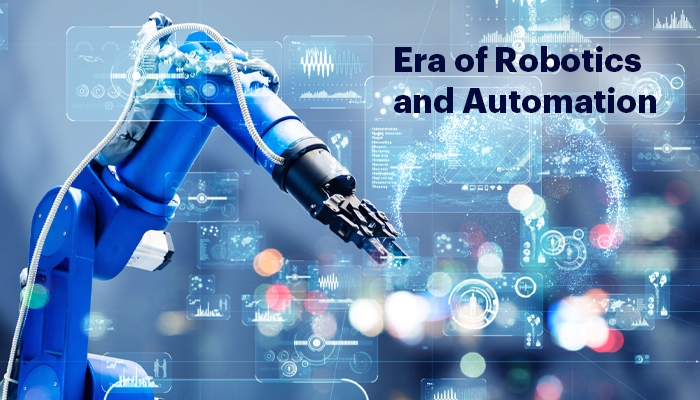The rise of robotics and automation, which are revolutionising sectors and redefining the future of employment, has been made possible by the quickening pace of technological advancement. Robots and automated systems are revolutionising workplaces in a variety of industries by performing jobs quickly, precisely, and efficiently. This blog will examine the dramatic effects of robotics and automation on the workforce, as well as its advantages, drawbacks, and potential applications in the future.
I. The Rise of Robotics and Automation
Automation and robotics have a long history that may be traced to the Industrial Revolution. However, recent developments in fields like robotics engineering, machine learning, and artificial intelligence have expedited their acceptance. Robotics and automated systems have shown to be very beneficial for businesses in the manufacturing, healthcare, logistics, agricultural, and hospitality sectors.
II. Transforming the Workplace
The dynamics of the job market have undergone a paradigm shift as a result of the advent of robotics and automation in the workplace. While job loss is a problem, it is important to understand that automation also opens up new career paths and work possibilities. Automation frequently increases human workers’ capabilities rather than completely replacing them, which boosts output and increases job happiness.
III. Benefits of Robotics and Automation in the Workplace
Automation and robots have numerous benefits. Business productivity and efficiency can be dramatically increased by automating repetitive and boring processes. Precision and accuracy are two further areas where robots and automated systems thrive, lowering the margin of error in crucial activities. Additionally, their capacity to work nonstop without becoming tired permits 24/7 output and decreased downtime. Automation frequently results in cost reductions for businesses as well as higher profitability.
IV. Challenges and Concerns
Automation and robotics have many advantages, but they also pose problems and raise concerns. Potential job loss and its financial repercussions are among the main worries. Certain job roles can become outdated as technology develops, necessitating worker adaptation and the acquisition of new skills. Since the use of robots and automation might lessen the human touch in some businesses and affect customers’ experiences, ethical issues also come into play. The collecting and storage of sensitive data in automated systems raises privacy and security problems that need to be taken care of as well.
V. Collaborative Robotics (Cobots)
Cobots, also known as collaborative robots, are a significant advancement in the robotics industry. Cobots are intended to work alongside humans, boosting their capabilities and safety, as opposed to regular robots that function autonomously. Cobots allow for human-robot collaboration, where the capabilities of humans and robots are complemented, resulting in greater productivity, better ergonomics, and safer working conditions. The potential of cobots in many industries is highlighted by numerous success stories.
VI. Industries at the Forefront of Robotics and Automation
A number of sectors are leading the way in embracing automation and robotics. Robots are replacing monotonous and dangerous work in manufacturing and assembly processes, which has resulted in substantial alterations. Robots help in operations, patient care, and drug delivery in the healthcare and medical fields, enhancing accuracy and patient outcomes. Automation helps logistics and warehousing by optimising supply chains and enhancing order fulfilment. Robots are used in farming and agriculture for crop monitoring, harvesting, and precision farming. Even the service and hospitality sectors are investigating the use of robots for everyday activities and customer service.
VII. The Future of Work:
Possibilities and Prognostications A harmonious fusion of robotic technology and human intelligence is anticipated for the workplace of the future. The use of “augmented intelligence,” in which intelligent machines collaborate with humans, will spread. There will be a need for a workforce that is skilled at cooperating with robots and utilising their potential as new employment positions and industries arise. Automation frees up time for more fulfilling and creative activities, which will have a substantial impact on employee wellbeing and work-life balance.
VIII. Government Policies and Regulations
Robust government policies and regulations are required as robotics and automation grow more commonplace. It’s critical to strike a balance between innovation and worker safety in order to maximise the positive effects of automation while minimising any potential negative effects. Global viewpoints on robotics and automation legislation offer insightful suggestions for fostering a responsible and moral application of this game-changing technology.
Conclusion:
Automation and robotics have the potential to significantly alter how work is done in the future. Benefits include higher production, better precision, and more safety result from their incorporation into numerous businesses. While there are obstacles, such as worries about job loss and ethical issues, the possibility of human-robot collaboration presents fascinating opportunities. As we accept this technological transformation, we must reskill and upskill the workforce, modify regulatory frameworks, and embrace the transformative possibilities of robotics and automation in order to be ready for the future of work. By doing this, we can use their influence to construct a future of work that is more effective, efficient, and inclusive.



